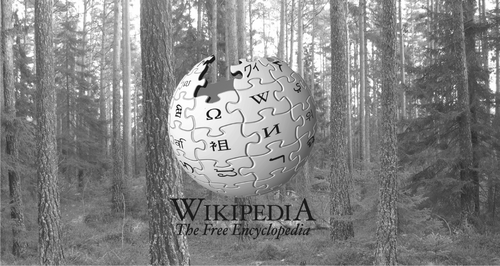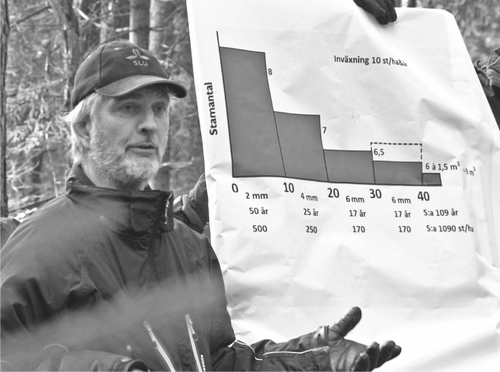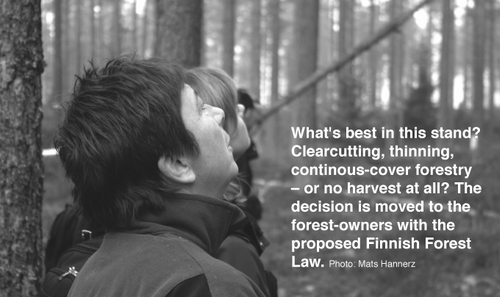
What's true about the forest? Millions of people use Wikipedia to find the facts. Photo: Mats Hannerz
SLU pioneer contributions to Wikipedia
SLU, the Swedish University of Agrucultural Sciences, is the first university in the world that officially and actively contribute with knowledge on Wikipedia.
Wikipedia has become the largest and most used reference work on the Internet with an estimated 365 million readers worldwide. Its role as a source of knowledge for the public continues to increase. Search engines almost exclusively give top ranking to Wikipedia pages.
Students use it on a daily basis, even at the university level. It is therefore natural for SLU to want to contribute and validate the content of Wikipedia articles within its fields of expertise.
The Wikipedian project at SLU was launched in January 2013. The initiative came from a dedicated researcher, Olle Terenius, and the idea was endorsed by the university administration. With financial support from Formas, a “Wikipedian in Academy”* was hired for helping researchers to get started.

Olle Terenius initiated the Wikipedia project at SLU. He is an ecologist working with insects, immunity and infections. Photo: Jenny Svennås-Gillner SLU
* A Wikipedian in Academy (more commonly referred to as Wikipedian in Residence) is a role which aims to serve as a liaison between the organization and the Wikimedia community to promote a mutually beneficial cooperation.
Olle Terenius acknowledges that the Internet has become the major source of information for journalists, students and researchers. Wikipedia articles are often considered sufficiently reliable for the needs of the public, but when experts check their specific areas of interest, they often find mistakes or information gaps.
– As experts, we have an obligation to spread our knowledge to a wider audience, he says. Wikipedia is a fantastic place to disseminate our findings, since it is used by millions of people.
He stresses that a Wikipedia contribution can be made with a minimal effort. A five-minute job to correct a reference or adding a sentence can change an article from being incorrect to correct, thus benefiting the readers.
– Unlike information channels, with long processing times, Wikipedia gives the writer instant satisfaction. Many writers also get feedback from other readers.
15 languages
Most of the work is done on the Swedish version of Wikipedia, but SLU has prepared pages for 15 different languages, to allow, for example, guest researchers to write on their own languages.
– The English Wikipedia is usually quite reliable, but articles in less widespread languages need more elaboration, says Olle Terenius.
Researchers at SLU write for Wikipedia with a clear affiliation to the institution and, thus, their contribution can be traced in the article history. One goal is that at least 100 researchers will contribute articles, or parts of articles, over the one-year project. So far, about 30–40 researchers are registered as contributors.
The third task
One of them is Associate professor Lars Lundqvist at SLU in Umeå. His fields of expertise are within silviculture, and particularly continuous-cover forestry. To date, he has a long list of topics for which new texts are needed, or where existing texts need amending.
Why is he devoting time to the Wikipedia project?
– The university has a responsibility to inform the public. This “third task”, alongside research and education, needs much more attention. Wikipedia is one of many channels we can use for the task, but a very important channel since so many people use it, he says.
He observes that many articles on forests and forestry are superficial and sometimes contain misleading information. As a researcher, he has a responsibility to correct it. His students often use Wikipedia for their project work. By improving the content, he also ensures that they find relevant facts.
– Many new terms, such as those related to continuous-cover forestry, were missing from Wikipedia. I have been able to add information on those, he says.

Lars Lundqvist: “Informing the public is one of the responsibilities for a scientist. The Wikipedia project is a good project in that sense”. Photo: Mats Hannerz
Is it worthwhile to spend time on popular science and public education? Lars Lundqvist hesitates somewhat about the answer, but concludes that the answer is “No” – at least not for academic positions, where scientific publication overshadows other activities. But he would like to see a more positive attitude towards popular science.
– A good scientist must also be able to show that he or she can disseminate their results and make them understandable to others.
The Wikipedia project at SLU is pioneering, in a global context, in the way that a university cooperates officially with the Wikimedia foundation. So far, Wikipedia projects linked to universities have been based on student contributions and individual researchers.
A sentence from the project description provides a good reason for collaborating with Wikipedia:
“Let's get the experts at SLU to publish information where everyone reads it!”
About Wikipedia (from Wikipedia):
Wikipedia is a collaboratively edited, multilingual, free Internet encyclopaedia supported by the non-profit Wikimedia Foundation. It was launched on January 15, 2001, by Jimmy Wales and Larry Sanger. Sanger coined the name Wikipedia, which is a portmanteau of wiki (a type of collaborative website, from the Hawaiian word wiki, meaning “quick”) and encyclopaedia. In early 2013, Wikipedia has 26 million articles in 286 languages.
The open nature of Wikipedia has led to various concerns, such as the quality of writing, the amount of vandalism and the accuracy of information. Some articles contain unverified or inconsistent information, though a 2005 investigation in Nature showed that the science articles they compared came close to the level of accuracy of Encyclopaedia Britannica and had a similar rate of “serious errors”.

More freedom for owners with a revision of Finnish forest law
Decision-making moved from authorities to forest owners, and a greater diversity of management allowed. These may be the results if the reformed Finnish forest law is enacted by their parliament.
A proposal for a changed forest law was released for consultation in February 2013. The proposal has piqued interest in other countries, since it involves a shift from detailed regulations to more freedom for the forest owner.
Matti Mäkelä at the Ministry of Agriculture and Forestry was secretary of the committee that produced the proposal. He explains that the proposal is technically not a new law, but a reform of the current law, which dates back to 1996.
The purpose of the reformed law is to secure sustainable forest management, but not through detailed restrictions. Instead, more responsibility is placed on the forest owners.
“We know that many forest owners are concerned about biodiversity and have other goals than pure economics. The reformed law will allow for greater variety in management”, says Matti Mäkelä.

“The purpose of the law will remain the same, but the new law will secure sustainable forest management”, says Matti Mäkelä. Photo: Mats Hannerz
Uneven-aged forestry is one example of management that is restricted under the current law. This law also has regulations about which tree species to plant. Such regulations will now be removed.
"Continuous cover forestry and more broadleaved forestry may become more common after the new law is enacted”, he predicts.
Other changes include abandoning age and dimension limits for final harvest of a forest, and also less strict rules on thinning. Such changes should allow more efficient forest management and an increased harvest.
Reforestation will still be required, but not for clearcuts less than 0.3 hectares.
The decision will be taken by the parliament in 2013, and, if supported, will become law from January 2014.
Phytophthora – new threat with knowledge gaps
Diseases caused by Phytophthora pathogens are an increasing problem in nurseries, landscape plantings and forests throughout the world. Phytophthora can infest and harm both deciduous and coniferous trees, in both the seedling and mature stages. The diseases are difficult to detect and control.
Phytophthora spreads through movement of infected plants and via contaminated soil and water, and some species are also transmitted in the air. The international trade in plants has been highlighted as a major route by which Phytophthora reaches new areas.
SNS-supported network
In 2012 SNS began to support a specific network based on the theme “Phyotphthora-diseases of deciduous forest trees in Nordic and North- European regions”. The first meeting was held in early 2012.
Altogether 16 scientists and PhD students from Germany, Estonia, Norway, Finland and Sweden gathered in Malmö, Sweden, to discuss the disease. They also visited beech-dominated forests with severe symptoms.
Lack of detailed and systematic information about the occurrence of Phytophthora species in the region was identified as a major knowledge gap. This gap will be addressed in future joint studies and workshops.
Contact: Johanna Witzell, SLU (coordinator, [email protected]) Information on the network N 2012-04 can be found on the SNS website, www.nordicforestresearch.org .
SNS is also supporting research on Phytophthora in a 3-year project (SNS-117: Prevention and restorative measures to reduce damage to forests – Phytophthora diseases in focus). The project is briefly described in News & Views No. 3, 2013.
Shortcuts
Ash decline is the subject n focus of most downloaded article
One article stands out in recent statistics relating to downloads from Scandinavian Journal of Forest Research. The article “Clonal differences in susceptibility to the dieback of Fraxinus excelsior in southern Sweden” by Lars-Göran Stener was first published online in 2012. It was promoted with a press release at a time when the ash decline was being featured in UK media. The press release resulted in 700 downloads in 48 hours and 2,965 downloads up to early April 2013. The paper has been cited in many media features and websites. E-mails with thanks for the information were even received from Greenpeace, along with acknowledgements from newspapers such as The Telegraph and the Daily Mirror.
Lars-Göran Stener, is satisfied with the attention the study has received. A number of questions from the media and other researchers have been sent to him by e-mail.
– The attention helps us to bring into focus potential solutions to preserve the species, and it will hopefully lead to more research, he says.
The article is in Volume 8, issue 3, and can be downloaded free. Check it out on www.tandfonline.com/sfor

Lars-Göran Stener – most read researcher Photo: Mats Hannerz
Nordic council
Blogging by the Secretary General
The new Secretary General of the Nordic Council of Ministers, Dagfin Høybråten, uses a blog to disseminate information about the council's work on developing and boosting Nordic co-operation. Check out www.norden.org and search for “secretary general's blog”.

Dagfin Høybråten – a blogger Photo: Johannes Jansson/norden.org
Estonia
Forestry director becomes vice-rector
Paavo Kaimre, director of the Institute of Forestry and Rural Engineering in Estonia, was installed on 1 January 2013 as vicerector of studies at the Estonian University of Life Sciences.
Read more on www.emu.ee

Paavo Kaimre – new vice-rector Photo: Mats Hannerz
Sweden
Many applications for academic course for forest owners
The academic course Sustainable smallscale forestry (Hållbart familjeskogsbruk) was ranked as the second most popular course at the Linnaeus University when application statistics for autumn 2013 were compiled. The distance-learning course, administered from Växjö in southern Sweden, has so far recruited over 3,000 students. Many of them are forest owners who want to improve their competence in forest planning, silviculture, economics and property maintenance.
Read more at www.lnu.se
Norway
Bioenergy award to Solør Bioenergi
The Bioenergy Innovation Award 2013 was given to Solør Bioenergi in southeastern Norway. The company uses exclusively impregnated wood in its combined heat and power plant. The 10 MW plant takes care of the hazardous waste and transforms it to energy. The awarding committee motivates the prize with “… a Norwegian company which has succeeded in exploiting possibilities to develop profitable activities. This has made the company one of Norway's leading operators in the field of bioenergy.”
Read more on Bioenergy Innovation Centre: www.sintef.no